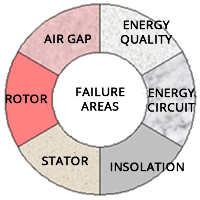 ID Ingeniería uses MCE 2010 equipment manufactured by PdMA and Series 435 Fluke equipment for engines and electric systems analysis. Through the combination of static and dynamic tests these provide an effective diagnosis of the motor and/or analyzed system. These techniques are valid for both, alternating and direct current motors.
Advantages of implementing predictive maintenance in motors
and electric systems:
 Reduction in unexpected production downtime due to failure in electrical equipment. Reduction in unexpected production downtime due to failure in electrical equipment.
 Reduction in repair and replacement costs of electrical equipment. Reduction in repair and replacement costs of electrical equipment.
 These tests do not damage electrical equipment. These tests do not damage electrical equipment. |

